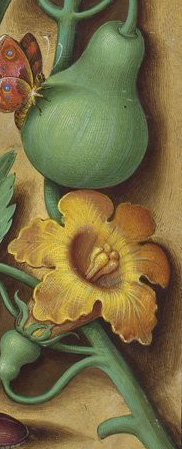With jack o’lanterns adorning our doorsteps, pumpkin pies just over the horizon, and a variety of winter squashes standing ready to warm a cool winter day, autumn is the season when the squashes have their moment of glory. It’s also the time to begin planning a crop of your own for next year.
Along with their cousins the cucumbers and melons, squash are among the most easily grown and most satisfying staples of the backyard garden. They can adorn lattices and rooftops with their yellow and orange flowers, and overtake even the most well-tended beds with their sprawling vines and large fruits. Squash are not only sunk into the American food consciousness, they are one of our native botanical treasures, and their diversity all but guarantees that some will grow well across the United States, and in almost any temperate area of the world.
Classified as Cucurbitaceae, the gourd family includes squash, melons, cucumbers, and gourds in dozens of varieties. They are all broad-growing vines that shoot out tendrils that climb, and they possess distinctive wide leaves and separate male and female flowers. The male flowers produce pollen, which is carried away by bees and other pollinating insects. The female flowers produce the fruit, a type of modified berry called a pepo. You can easily identify the female flower, as it carries a miniature version of the eventual fruit, just behind the petals.
What to Plant

 Pick varieties that you like to eat, and that are known to do well in your region. Summer squashes include zucchini, straightneck, and crookneck squashes; they have thinner and more palatable skin than their winter cousins. The familiar cucumbers come in both slicing varieties and pickling varieties; some are even globe-shaped. Melons, such as honeydew, cantaloupe, and watermelon, come in a variety of sizes, and gourds come in every shape and size — some, such as the loofah, are edible when young and useful in other ways when they mature.
Pick varieties that you like to eat, and that are known to do well in your region. Summer squashes include zucchini, straightneck, and crookneck squashes; they have thinner and more palatable skin than their winter cousins. The familiar cucumbers come in both slicing varieties and pickling varieties; some are even globe-shaped. Melons, such as honeydew, cantaloupe, and watermelon, come in a variety of sizes, and gourds come in every shape and size — some, such as the loofah, are edible when young and useful in other ways when they mature.
Winter squashes such as butternut, pumpkin, and acorn squash are harvested in autumn or early winter, but do not let the name fool you: these are warm-weather plants. Their winter appellation refers to when they are enjoyed, not when they are grown. These varieties can take more than a hundred days to mature, so plant them at the same time as the summer squashes, but expect to harvest them up until the first frost. Unlike their summer cousins, winter squashes have harder rinds and can store all winter without rotting or losing flavor.
Soil and Planting
All cucurbits are planted in the spring after the last frost. Plant them in a location where they will get six to eight hours of sun each day and can sprawl out several yards, or provide adequate climbing structures for the vine to climb on. All cucurbits can be trained to climb, but heavier-fruited varieties are best left to grow on the ground. Cucurbits require well-drained soil, rich in organic matter. Till in compost or rotted manure (not the fresh stuff, which may be high in salts, or contain weed seeds). This will loosen and improve soil conditions. Cucurbit vines thrive on high nitrogen levels, which produce vigorous vines, but if you fertilize after the flowers form, switch to higher phosphorus and potassium levels to develop healthy fruit. Your best bet is to go with the traditional method of digging in plenty of well-rotted manure at the start and leaving it at that.
If you are planting from seed, make small mounds of dirt and plant two or three seeds into the soil one inch deep. In the early stages of growth, the plant needs plenty of water, but do not water overhead because this encourages fungal diseases, which will stress the plant. A good rule of thumb, especially in the hotter months of summer, is to water deeply in the morning and then the next day check to make sure the soil has not dried out completely. Once the plant emerges and gets its first true leaves, you can switch to watering every few days and eventually to the recommended deep watering once a week. Remember that their fruits are mostly water, so they will need consistent moisture once the fruits start to form.
Growing and Harvesting

 Once the flowers start to form, you can help the pollinators with their job by transferring pollen from the male to the female flowers; a fingertip or cotton swab works well. As the fruit grows, make sure that any contact with the ground does not invite pests or rot. Elevate the fruit on some straw, mulch, dry dirt, or even a plate or piece of wood. There are many theories on how to tell if the fruit is ripe, but the most accurate is your direct experience with the plant and lots of trial and error. One plant may have a dozen fruit on it, all of which will ripen at slightly different times depending on when the fruit was pollinated and where it is on the vine. Size does not indicate ripeness; some fruit may be large and too young for harvest, while other fruit on the same plant will be smaller but ready. Color, the texture of the rind, and the look of the stem on the fruit can give you some pretty accurate information if you know what to look for. Also, keeping good records helps. Most seed packets will tell you approximate growing times and harvesting notes.
Once the flowers start to form, you can help the pollinators with their job by transferring pollen from the male to the female flowers; a fingertip or cotton swab works well. As the fruit grows, make sure that any contact with the ground does not invite pests or rot. Elevate the fruit on some straw, mulch, dry dirt, or even a plate or piece of wood. There are many theories on how to tell if the fruit is ripe, but the most accurate is your direct experience with the plant and lots of trial and error. One plant may have a dozen fruit on it, all of which will ripen at slightly different times depending on when the fruit was pollinated and where it is on the vine. Size does not indicate ripeness; some fruit may be large and too young for harvest, while other fruit on the same plant will be smaller but ready. Color, the texture of the rind, and the look of the stem on the fruit can give you some pretty accurate information if you know what to look for. Also, keeping good records helps. Most seed packets will tell you approximate growing times and harvesting notes.
Summer squashes such as zucchini and yellow squashes can be harvested any time after pollination, and are so prolific that you want to harvest them regularly, even daily. Never let a zucchini harvest get away from you. Harvest by cutting the stem. Summer squashes can be stored for about a week at room temperature, and a little longer in the fridge.
Melons are best when allowed to mature on the vine; if you can smell the sweet melon scent, it’s time to harvest. When you harvest melons, gently lift them and twist them off the vine. Melons are ready to eat from the moment they are picked; cantaloupes continue to ripen off the vine, but other melons don’t.
For winter squash, cut off the fruit about one inch above the stem once the rind has hardened and the vine begins to lose vigor. They can be stored in a cool and dry place for up to three months. Storing the fruit further hardens the rind and often enhances its flavor. For this reason, winter squashes are usually eaten after being allowed to mature off the vine for at least a little while.
For gourds, harvesting depends on the variety. If the weather is dry, gourds can dry on the vine after it dies; otherwise they should be harvested and hung to dry.
Pests and Disease

 Cucurbits are easy to grow and, once established, can provide a lot of food. They are susceptible to root issues (usually due to overwatering) and can suffer from mildew. In cases of soil-borne diseases, plant leaves will wilt, and fruit will rot with a distinctive slimy white mold. Mildew can cause lesions on the leaves, a powdery residue, and premature drying of the fruit on the stem. Mildew usually won’t kill the plant completely, but it can lead to defoliation, which leaves the fruit more exposed to the elements. In both cases, healthy plants fare better. In addition to good soil and proper watering, good crop rotation and early removal of infected leaves and plants helps mitigate the risk.
Cucurbits are easy to grow and, once established, can provide a lot of food. They are susceptible to root issues (usually due to overwatering) and can suffer from mildew. In cases of soil-borne diseases, plant leaves will wilt, and fruit will rot with a distinctive slimy white mold. Mildew can cause lesions on the leaves, a powdery residue, and premature drying of the fruit on the stem. Mildew usually won’t kill the plant completely, but it can lead to defoliation, which leaves the fruit more exposed to the elements. In both cases, healthy plants fare better. In addition to good soil and proper watering, good crop rotation and early removal of infected leaves and plants helps mitigate the risk.
Pests such as squash bugs and cucumber beetles can be particularly damaging. The approach to dealing with them is one of management, not eradication. A three-part strategy will help deal with these pests:
Search & Destroy. Find the adult bugs or beetles by thoroughly inspecting the plants and the undersides of the leaves. Then pick them off by hand, or spray them with a water and dish soap solution, which will kill the pests on contact. Chickens and ducks also don’t mind helping with this task, but must be carefully managed to ensure that their eager search for bugs doesn’t destroy the plants as well.
Reduce Numbers. Search for squash bug eggs under the leaves; they are generally tan to brown, egg-shaped, and arranged in neat clusters; squish them on sight. Between growing seasons, till up the soil and remove mulch to let the winter kill off any cucumber beetle eggs laid in the soil.
Rotate crops. Move your crop of cucurbits each year. This type of plant rotation may be the best way to reduce pest damage. It often also has other benefits for soil and plant health.
Join Our Telegram Group : Salvation & Prosperity







